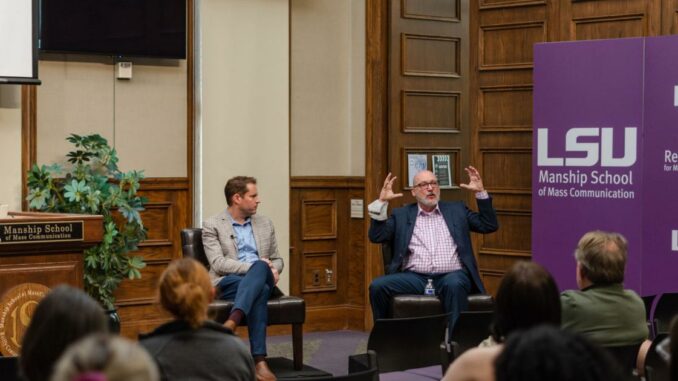
Tony Plohetski, an Austin American-Statesman reporter who had spent weeks covering the shooting in Uvalde, Texas, got a late-night call from a source that was a turning point in the massacre’s coverage.
“Come get the video,” the source told him.
The gut-wrenching, 77-minute security camera footage showed law enforcement officers standing idly by for over an hour while a gunman fired shots in a closed elementary school classroom.
Plohetski and his top editor, Manny Garcia, spoke to students at LSU’s Manship School of Mass Communication on Monday about the video’s consequences and what it was like to cover one of the deadliest school shootings in U.S. history. The gunman killed 19 children and two teachers.
They provided a behind-the-scenes account of covering one of the most emotionally wrenching stories in recent memory—and one that was closely followed by people across the country. Their talk was part of a series of events at the Manship School designed to take a closer view of what reporters do and the value of it.
Plohetski’s coverage of the shooting began after he saw early reports on Twitter on what had felt like an ordinary day in May 2022. Garcia asked him to make some calls.
“I don’t know anything about death toll, but I can tell you this is going to be very bad,” a top official with the Texas Department of Public Safety told him.
He soon learned the death toll was over a dozen.
“I knew then that this was going to be a national nightmare and a national tragedy,” Plohetski said.
Soon after, he made the 2 1/2-hour drive from Austin to Uvalde, a small town about 80 miles west of San Antonio, making and receiving phone calls along the way. His first stop was the
Town Square, where members of the community had gathered for prayer vigils. Then he went to the school.
Austin American-Statesman reporter Tony Plohetski shows a video of himself reporting on the Uvalde school shooting on Monday, March 6, 2023, as part of a talk about covering the Uvalde school shooting given at the LSU Journalism Building in Baton Rouge, La.
Back in Austin, Garcia said he was focused on getting information about the shooting posted online and mobilizing reporters and photographers to Uvalde. He started downloading pictures of staff of the Robb Elementary School website, not yet knowing which of them were among the dead.
“Think of a Category Five hurricane of information, where it’s just pounding you and pounding you and pounding you hour after hour after hour,” Plohetski said. “And that’s what it feels like to be a journalist in a situation like this.”
The video, published in July by the Austin American-Statesman, was a pivotal moment in the news coverage that was dissecting the narratives of supposed law enforcement heroism painted by government officials after the shooting.
Plohetski said a law enforcement source reached out to him to show the 77-minute security footage from inside the school, capturing officers checking their phone, using hand sanitizer and fist bumping each other while children and their teachers were alone with a gunman.
Plohetski was the first reporter to see the video. He negotiated with his source to publish a screenshot of the officers in the hallway, and he could report on what he had seen in the video.
When it ran on the front page of the paper, the reaction to the screenshot was “like a bomb went off,” Garcia said.
“I knew then that the public had to see, come hell or high water, that video,” Plohetski said.
When a source told him he could pick up a copy of the video one night, Plohetski did not even tell his spouse where he was going out of an abundance of caution to protect his source.
Plohetski, Garcia and their team began to discuss next steps late that night.
They unanimously decided they would take out the audio of the children screaming, Garcia said. But “we decided we were absolutely gonna run the gunshots because this is what an AR-15 sounds like when it’s killing people in a classroom,” he said.
The gunshots also put the law enforcement inaction into context–48 minutes in, another round of shots was heard. The officers did not breach the classroom until 21 minutes later, killing the 18-year-old gunman, they say, at that point.
The Austin American-Statesman made a shortened, four-minute version of the video to show the most important parts, while also making the full-length video available to the public.
“I think that we felt that we had served the public by bringing truth and reality,” Plohetski said.
But not everyone was happy the truth was out.
Plohetski said he and Garcia received death threats after publishing the video. Garcia called him multiple times a day to check in after the video was published, Plohetski said.
The Austin-American Statesman’s coverage of the shooting has not stopped. Plohetski said he did over 50 network interviews in the days following the shooting. 10 months later, they are still trying to obtain more information from authorities.
“Sooner or later, the truth comes out,” Garcia said.

Leave a Reply